

|
| articles | forbidden stories I-State Lines resources my hidden history reviews | home | |

Writing/Literature Don't Write for Readers, Just Write Grants American Identity Hapas: The New America Can You Tell What I am? Part I Can You Tell What I am? Part II Only in America Unfolding Crises: Asia China: An Interim Report Shanghai Postcard 2004 Japan's Runaway Debt Train Battle for the Soul of America A Degree of Success Why the Democrats Keep Losing American Chickenhawks: Your Congress Is This a Nation at War? A Nation in Denial Financial Meltdown Watch Are We Entering the Next Age of Turmoil? Housing Bubble? What Bubble? Housing Bubble II Meltdown in the E.U. Meltdown: U.S. - China Retirees: the New Elite? Boomers: Prepare to Fall on Your Swords The Real Federal Deficit How much Is a Gallon of Gas Worth? What This Country Needs Is a... Good Recession Outside the Box How to Make a Favicon Asian Emoticons In Memoriam: Winky Cosmos In a Humorous Vein If Only Writers Had Uniforms Ideas On The Impermanence of Work Flattening the Knowledge Curve: The "Googling" Effect Human Bandwidth and Knowledge History Bad Karma: Election Fraud 1960 Archives: weblog June 2005 weblog May 2005 What's New, 2/03 - 5/05 |
Weblog and Wessays Welcome, readers, welcome. Please browse this month's weblogs and the wEssays listed in the sidebar. If you're in the mood for a short story, check out The Adventures of Daz and Alex: Stories of America. (They're all quick reads.) If nothing here strikes your fancy, skim through my recently published articles. If you find something here of value, I would be honored if you linked any essay or story to your website, or printed a copy for your own use. And of course I appreciate your recommendations of this weblog and your comments: csmith@oftwominds.com. July 31, 2005 Fairness and "Charley Michael": Continue Mission Spending 10 days in my former hometown of Honolulu has naturally increased my awareness of news in Hawaii. One factor of national import has not been reported: the National Guard of Hawaii, drawn from one of the nation's smallest state populations, is providing a disproportionate share of the National Guard personnel serving "in theatre" in Iraq and Afganistan. Of approximately 150,000 U.S. troops in theatre, some 10,000 are Hawaii National Guard. (These numbers are from major media sources in Hawaii.) Is the deployment of so many Hawaii National Guard fair? It's hard to see how it could be, given that Hawaii has just over a million residents in a nation of 300 million people. On a pro-rated basis, the Hawaii National Guard should have at most several hundred people serving on active duty, not 10,000. Why this huge disparity? My own theory is that the military is well aware of Hawaii's long tradition of service and sacrifice. The tradition stretches back to the Japanese-American soldiers of the 442nd in World War Two, whose unstinting courage and determination made the 442nd the most decorated unit of the U.S. Army. Much of the history of people in Hawaii from 1880 to the present has been one of immigration, and one truism of the immigrant experience is proving patriotism through military service. As a result of these traditions, Hawaii's people volunteer and serve in disproportionate numbers, and serve without complaint. The Honolulu newspapers quite rightly refer to Hawaii National Guards personnel as citizen-soldiers, and their front-page stories of local soldiers quite rightly keep their service and sacrifice foremost in the minds of their readers. But maybe someone in Hawaii should question why one of the smallest states is providing one of the largest active National Guard contingents, and why the Hawaii National Guard is on duty in a "hot warzone" rather than replacing regular Army units serving in snoozeville billets like Germany or East Asia (Japan, Okinawa, etc.) July 17, 2005 I'm off on a project which takes me away from daily contact with the Web (I reckon I'll survive somehow), so this is my last entry for the next 11 days. As a poor substitute, please poke around other bits of the site, such as this piece on the patterns found in classic Chinese garden courtyards, 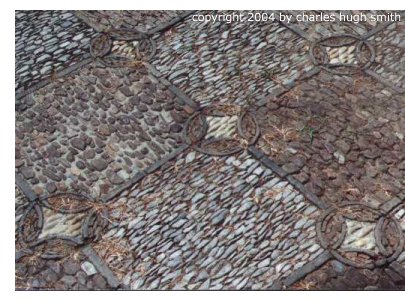 which for some reason gets a lot of hits from Web searchers. Here's a sample
photo from the piece.
which for some reason gets a lot of hits from Web searchers. Here's a sample
photo from the piece.
Film buffs might enjoy a look at my list of French Tough guy Films. At a reader's request, I've posted the next two chapters of Claire's Great Adventure; Chapter Two and Chapter Three. Music fans may get a kick out of King George Is Back, a witty send-up of our Prez, or a classically funky version of All Along the Watchtower, as only a group of old friends having fun could play. (I play second lead guitar on both.) For short fiction, you might try First Night Out: Las Vegas from The Adventures of Daz and Alex, or The 29-Year Old and Her Favor from Forbidden Stories. In light of the conflict in Iraq, you might be interested in my review of a little-known classic account of the Vietnam War, Big Story: How the American Press and Television Reported and Interpreted the Crisis of Tet 1968 in Vietnam and Washington. Just go to Serious fun (non-fiction) and scroll through the reviews, which also include commentaries on other classics such as Creativity and Taoism, The Mystery of Capital: Why Capitalism Triumphs in the West and Fails Everywhere Else and The Rape of Nanking: The Forgotten Holocaust of World War II. Anyone interested in interior design, China or architecture might find China Ironies about an American architect's home in Suzhou, China of interest. I hope you can find some point of amusement somewhere in the offerings; if not, please check back on July 29. July 16, 2005 Demographics, War and More Academic research suggests that armed conflicts are most likely when the population of young males vis a vis the total population is abnormally high. Although I can't find a link to the study, I recall one that showed the correlation was evident in the American Civil War and both world wars. The take-away from this is obvious: wars and conflicts will go away not when they're resolved militarily but when the unstable mass of volatile young men age into their 30s: World Peace, Thanks to Old Men? The recent high birth-rate driven population explosion in the Mideast and Africa has created just such a huge "bubble" of underemployed, angry, disenfranchised young men. As a result, some C.I.A. studies suggest that the Mideast will be rife with conflict until about 2015, when this cohort has moved into middle-age and the birthrate has dropped. Africa, sadly, has even greater demographic problems: the death of middle-aged parents from AIDS is creating an enormous cohort of poorly nourished, poorly educated, often abandoned orphans. Some observers believe this correlation is being used to demonize the young and restless: Angry Young Men. But the politicizing of the correlation does not negate the correlation. The importance of the correlation is precisely that it operates on a larger scale than mere politics; it is a population dynamic with roots deep in animal population behavior. Perhaps this abundence-of-angry-young-men-leads-to-conflicts correlation is just one of a larger subset of similar population dynamics--chief among them being the rise of populations as new food sources are exploited and the rapid die-off of these populations when those resources are depleted. This is, after all, the pattern followed by all organisms. In untrammeled Nature, most species are unable to fully exploit their environment due to pressure from predators and the limitations of disease, climate and food. We humans, freed long ago from serious predation and all but the most severe climate and disease restrictions by our agriculture and tools, appear to have no such restraints on our population. Clearly, the 6.5 billion humans now alive are testament to that unfettered trajectory. 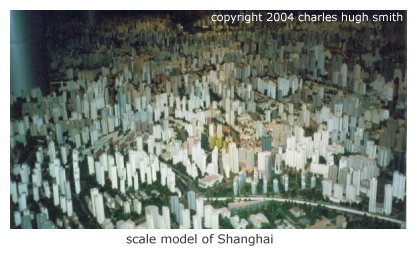 But Nature has mechanisms which can rear up to lay waste to even the most spectacularly successful species. The
process may begin with overcrowding, which leads to conflict and diminishing returns on previously successful
food procurement strategies. These result in a widespread reduction in the population's immune strength, which combined with the physical
overcrowding, enables the rapid transference of disease.
But Nature has mechanisms which can rear up to lay waste to even the most spectacularly successful species. The
process may begin with overcrowding, which leads to conflict and diminishing returns on previously successful
food procurement strategies. These result in a widespread reduction in the population's immune strength, which combined with the physical
overcrowding, enables the rapid transference of disease.
Diseases which were sequestered in remote populations are suddenly free to spread through a much wider and less resistant population, enabling rapid mutation of new more virulent strains of the disease. The most famous example of such a disease is the Black Death plague, which killed a third of Europe's population and untold millions elsewhere on the globe before dying out--that is, either killing every suseptible person or encountering an immune response robust enough to vaccinate the victim against future infections. It took many generations simply to repopulate the villages which had been abandoned wholesale by a rapidly decreasing population. Given humanity's dependence on a handful of grain crops, the same effect could be rendered by the wide scythe of disease-borne death decimating one of these essential cereal crops. Ever-restless humanity has also added to the mechanisms Nature might turn to for a species-wide die-off. As we heat up the planet by burning immense quantities of hydrocarbons, thus releasing greenhouse gases in the millions of tons, we may be disrupting irreplaceable sources of food such as the Gulf Stream and various breadbasket areas of the planet. Last but not least, we have weapons of mass destruction, which could be used with terrible consequences on overcrowded megalopolises. In our great species-centric hubris, we tend to look at these problems through the lens of politics or national self-interest or even spiritual righteousness. But the truth is more likely that planetary and species-wide forces beyond human meddling are already in play, and we are largely reduced to observers, able at best to tend the leading edges of the forces we have unleashed with our agricultural and tool-making success. Perhaps that is too bleak an assessment; perhaps we can yet slow the global warming juggernaught and eradicate the potential for a global pandemic from avian flu or its equivalent. But it's worth looking at our species from the disinterested perspective of a population biologist, and considering the dynamics of the environment and species from that longer, broader view. July 15, 2005 The Purpose-Driven Life and Jihad The book The Purpose-Driven Life: What on Earth Am I Here For? has sold tens of millions of copies in the U.S., on the obvious strength that it is a 40-day/40-chapter guide to Christian living by Rick Warren, a popular pastor of a Southern California mega-church (89,000 members and counting, with 9,000 ministers serving thousands of smaller groups of worshipers within the church membership). Warren focuses his "purpose-driven life" around worship, community, discipleship, ministry and evangelism, and quotes scripture from the Bible to support his views. What strikes me about the four young suicide bombers in London is that they too were seeking a purpose-driven life, and they happened upon a puppet-master who sold them on Jihad as a noble, highly spiritual calling. My point is simply that the desire for a purpose-driven life is universal in humanity, and that a path of pure evil can be made to fill that need--and it need not be religious at all. Thousands of people glorify Che Guevara, who was primarily a cold-blooded killer, the puppet-master behind thousands of individuals' murder. Their "crimes against the Revolution" were often petty and unsubstantiated, but the noble-sounding revolutionary rhetoric was good enough to fill the void within those hungry for an answer, a calling or a purpose. Don't ask me where or how, but I heard this story first-hand from someone in a position to know. A guy walks into a Midwest Wal-Mart and loads up a shopping cart with cell phones. That strike someone as a wee bit suspicious, and so it's reported to the authorities, who track the guy to a local mosque which had been slipping cell phones in quantity to Iraq--where cellphones are used as detonators on bombs. There is no doubt that some among us have very purpose-driven lives, and they see themselves as highly spiritual and serving a noble calling. The calling is killing Americans, and it's sobering to consider how difficult it is to uncover and restrain that kind of fervor. July 14, 2005 How Much Longer Can We Go On Like This? 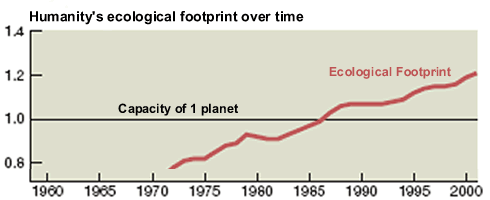 It's been 35 years since the first doom-and-gloom predictions for worldwide famine and exhaustion of natural
resources entered the culture, and every decade has mocked the predictions as wildly inaccurate. Nitrogen
fertilizers and cheap oil have staved off world hunger, and the exhaustion of natural resources keeps getting
pushed off into the distant future.
It's been 35 years since the first doom-and-gloom predictions for worldwide famine and exhaustion of natural
resources entered the culture, and every decade has mocked the predictions as wildly inaccurate. Nitrogen
fertilizers and cheap oil have staved off world hunger, and the exhaustion of natural resources keeps getting
pushed off into the distant future.
Now comes Kenneth Deffreyes, Princeton geologist and self-professed child of the Oklahoma oil fields, saying we're already at the end of rising oil production (and hence of cheap oil) in his new book Beyond Oil : The View from Hubbert's Peak According to Deffreyes, the optimistic view that oil production won't stop growing until 2036 or beyond is unsupported by the facts. He isn't saying the world is running out oil; what he's saying is the world is running out of cheap, easily accessible oil in large fields which can produce the 82 million barrels of oil humanity burns each and every day. Yes, more can be recovered from existing wells and more can be found--but not 82 million barrels a day's worth. Put simply, demand will outstrip supply for the first time ever, and the world is poorly placed to deal with that reality. In the short-term, a deep global recession could set back demand enough to create a temporary oil surplus, thus dropping prices; but as the accompanying chart indicates, the long-term trend is up. Deffreyes then spends the rest of the book looking at alternative sources of energy: natural gas, hydrogen (not an energy source but a way of storing energy), solar, biofuel, etc. He suggests we should have started work on this stuff 10 years ago, and now it's too late. Many people put their faith in the "market," that is, the interaction of price with supply and demand. Once oil goes to $100 a barrel, then alternatives will surface. That may well be true, but how long will the market take to create an alternative energy source for 50 million barrels of oil a day? There are physical limits on many alternatives. To take just one example: the tar sands of Canada. There's as much sludgy oil in sand in Western Canada as there is in Saudi Arabia, we're told; fantastic news for SUV owners everywhere! But the bloom comes off the rose once you start looking at production costs, the physical work required to mine the shale, extract the oil and then put the mountain of tailings somewhere approximating its original setting. But the key fact is this: production from the Canadian oil-shale fields is currently about 1 million barrels a day, with production expected to rise eventually to perhaps 5 million barrels a day--about 23% of U.S. needs (not to mention Canada's). And of course China is a big investor in Canadian oil fields, so a significant percentage of that production will be pumped into tankers heading for China. I myself would go for the option of covering every roof in the U.S. with solar arrays. New solar cell technology enables printing the collectors on flexible plastic sheeting (made from oil, of course) which bypasses the current technology's need for silicon and glass. This would reputedly generate about 700 MWatts of the 900 MWatts of electrical power the U.S. uses every day. But that technology is still in its infancy, and the cost of covering 50 million roofs would naturally be substantial. Somebody would have to get the ball rolling, as California is considering doing with a tax credit/subsidy. Bottom line: if Deffreyes is right--and read the book before dismissing his analysis--then we are collectively going to run out of cheap and plentiful oil long before technological marvels are in production to replace the missing millions of barrels of oil. The best hope seems to be chipping away at the deficit with some of everything: conservation being number one, and then alternative sources: more natural gas, biodiesel, solar, geothermal, you name it. Still, it appears likely there will be a "crunch time" as oil production drops and alternatives are not yet in place. Readers of this blog know that the window of 2007-2012 appears on long-term charts as the probable timeframe for a global financial depression. Could the proximate cause be the shortfall between the world's demand for oil and its dwindling production? After read Deffreyes' analysis, you might not be so sanguine. July 13, 2005 And the winner of the healthiest Cold Cereal Contest is-- Frosted Mini-Wheats! I'm joking, right? Those sugar-encrusted little rectangles of wheat, healthiest of all? But I jest not. After a careful review of cold cereals at the local Costco, it seems clear that Frosted Mini-Wheats have the least harmful combination of bad things (fat, sugar and salt) and the highest content of good things (protein and fiber). The big shocker was the high sodium (salt) content of so many of the cereals. If I was of a conspiracy bent of mind, I would suspect the pharmaceutical industry of secretly paying the cereals companies to load up their seemingly benign products with salt, thereby causing ever higher blood pressure in unsuspecting Americans, who would then require that many more doses of highly profitable blood-pressure reduction drugs... The second surprise was that the "healthier alternatives" (Raisin Bran and Kashi brand Go Lean) had excessive amounts of sugar and salt, decisively lowering their score in the "healthiest cereal" contest. But let's not get ahead of the analysis. Highest sugar content: Sugar Frosted Flakes? Nope: Raisin Bran (19 grams per serving), followed by Kashi brand Go Lean with 13 grams. (Some health food, eh?) Frosted Flakes and Frosted Mini-Wheats came in with 12 grams each. Good old Cheerios scored lowest with 1 gram, right in with Oatmeal. Cinnamon Toast Crunch scored high with 10 grams, and Wheat Chex tipped in with a modest 5 grams. Most calories from fat: Cinnamon Toast Crunch clocked in with 30 calories of fat in each 130-calorie serving (guess where the "crunch" comes from). Go Lean came in with 25 calories of fat in a 190-calorie serving, while Frosted Flakes checked with the lowest of all, 0 calories from fat. Way to go Tony! Mini-Wheats had only 10 calories of fat per serving. Highest salt content: Cheerios has 210 mg. of salt in each serving, as does Cinnamon Toast Crunch; Raisin Bran is weighed down by 300 mg. of salt, while Wheat Chex must be made in the Salton Sea, for it has a staggering 420 mg. of salt per serving--fully 20% of all the salt you should eat in a day. Meanwhile Frosted Mini-Wheats has only 5 mg. of salt, comparable to wholesome plain cooked Oatmeal with 0. Highest Fiber content: Tony the Tiger doesn't do too well on this one with only 1 gram of fiber--ditto for Cinnamon Toast Crunch. Cheerios comes with 3 grams of fiber, while Mini-Wheats contains a respectable 6 grams; leaders are Raisin Bran and Go Lean with 8 grams each. Highest Protein (cereal only, no milk): Go Lean tops out with 9 grams of protein, but Mini-Wheats comes in second with 6 grams, good old Oatmeal does well with 5 grams, while Cheerios and Honey Bunch of Oats score 3 grams and protein-deficient Tony the Tiger (Frosted Flakes) stumbles in with only 1 gram. Conclusion: if you look not just at sugar, calories and fat, but at salt, fiber and protein, then it's clear that Frosted Mini-Wheats is the healthiest all-around choice of uncooked breakfast cereals. Yes, the sugar content is high, but it's less than Raisin Bran or Go Lean, supposedly "healthier" cereals. With super-low sodium, it's my top pick for an "honest" cereal, right up there with oatmeal. All that extra salt in packaged foods is a real detriment to health. Mini-Wheats also scores at the top in fiber and protein. So what's not to like? Sure, Oatmeal is a healthy choice, and I eat a lot of it (with flax seeds for all that yummy omega 3)--but with honey, and who knows how much sucrose I add in that "healthy choice" fashion... maybe as much as those 12 grams on the the Mini-Wheats.... July 12, 2005 Are Our Cities Making Us Fat? Part II 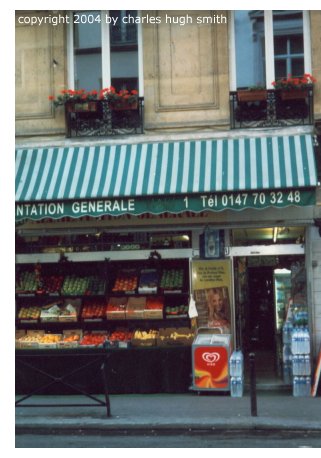 We all know walking is good for us, but what if there's no place to walk?
That's the conundrum facing most urban Americans: we know we're too sedentary, but there are no
conveniences or pleasant promenades nearby to draw us out. And so we get in our car to drive to the gym or
to a regional park for our walk.
Our suburban neighborhood might not even have sidewalks, much less a practical destination
within walking distance.
We all know walking is good for us, but what if there's no place to walk?
That's the conundrum facing most urban Americans: we know we're too sedentary, but there are no
conveniences or pleasant promenades nearby to draw us out. And so we get in our car to drive to the gym or
to a regional park for our walk.
Our suburban neighborhood might not even have sidewalks, much less a practical destination
within walking distance.
Meanwhile, residents in older city neighborhoods around the world--Kyoto, Bangkok, San Francisco, and as depicted here, Paris-- get their daily walk in simply running the errands of everyday life: commuting and shopping. This neighborhood market in Paris is typical of the many such small markets, drug stores, bakeries and cafes which dot every block of the metropolis. (The suburbs are a different and more auto-centric story.) You can place the line at 1900--cities planned and built before 1900 are still liveable for pedestrians, while those based on the ubiquity of automobiles are unliveable without a car and an infinite patience for traffic. Even older communities in famously car-centric Southern California are walkable; you could live in either Pasadena or Santa Monica, for instance, and live quite well with comfortable shoes and a bicycle if you worked somewhere in town--as people used to do. Liveability relies on simple features--broad sidewalks, a preponderance of narrow streets which pedestrians can cross without risking their lives, a street-level aggregation of utilitarian retail and service businesses, and transit nearby to facilitate moving people efficiently without having to provide parking for every single-passenger vehicle which makes its way into the neighborhood. There is nothing magical about these practicalities, but urban planning for much of the 20th century seemed designed to destroy each of these elements in turn. Now there is a movement in the U.S. to redress these idiocies which goes by the name of New Urbanism. A trend I have written about in the pages of the San Francisco Chronicle Magazine called "transit villages" is New Urbanism at its best: and I mean best both in terms of the conveniences provided to the village's residents/owners, and in the reduction of traffic congestion afforded everyone living in the urban zones nearby. Transit-oriented development (a.k.a. TOD) is another simple idea: take an existing transit hub--subway station, bus terminal, commuter train stop, etc.--and build a housing and retail complex close at hand. If you don't have a transit hub, then you can always use an existing downtown served by transit. This idea has completely transformed Honolulu's once-decrepit Chinatown district. Now all the area needs is more housing and some office space so people could live and work downtown. This is not a new idea; I recall Tony Hodges, our candidate for the House of Representatives in Hawaii, explaining the enormous environmental benefit of bringing workplace and housing together, back in 1976. Though traffic congestion and air pollution are the usual evils trotted out to explain the benefits of transit villages, you could add health; the biggest reason "French women don't get fat," as the recent book title proclaims, is not what they eat (lots of meat and cheese, horrors) but that they do their errands on foot. Perhaps it is not the French people who should wear the plaudits but their eminently walkable cities and villages. July 11, 2005 The decade in a word: Gold If you had to choose the most important word for the balance of this decade, what would it be? Wie, as in Michelle? Terrorism? Petroleum? My vote goes to gold--not as jewlery, but as a financial hedge against all the bad things which could start unfolding next year.  The belief in the inherent value of gold has been dismissed for 25 years as the rantings of "gold bugs,"
but take a look at this chart (courtesy of Barrons and eSignal) which tracks gold in non-Dollar currencies.
It shows what chartists call a "break-out," meaning that gold has broken out of a trading range and is reaching
new highs--highs which are cloaked to us in the U.S. by the current strength of the dollar.
The belief in the inherent value of gold has been dismissed for 25 years as the rantings of "gold bugs,"
but take a look at this chart (courtesy of Barrons and eSignal) which tracks gold in non-Dollar currencies.
It shows what chartists call a "break-out," meaning that gold has broken out of a trading range and is reaching
new highs--highs which are cloaked to us in the U.S. by the current strength of the dollar.
Gold is an interesting placeholder of value because you can buy the actual metal in coins, or gold mining stocks, or an exchange-traded fund (ETF) which holds physical gold. The Establishment (such a 60s word) or the Standard Economic Model (to paraphrase physics) has no use for gold. Everything is absolutely hunky-dory as is--low inflation, rising real estate values, low unemployment--this is the best of all possible economic worlds, and there is little Establishment doubt that any disruption would be short-term and modest in effect. Uh-huh. Still, I'm sticking with Gold as the key word for the next five years. It's something the "little guy" can buy to protect whatever assets he/she has accumulated--something which cannot be said for perquisites of the wealthy such as hedge funds. July 9 & 10, 2005 "Terroir"--California and France "A large part of what we call Nature, is not; it is even quite artificial, lacking both the state and the appearance that it would have in Nature.""Terroir" ("ter-wha" phonetically) is one of those French words dripping with cache (if you know what it means and can actually pronounce it, you're on your way to either being insufferable or actually learning something about wine) that has no analog in English; which is another way of saying that on occasion there is an actual reason to employ it other than snobbery. 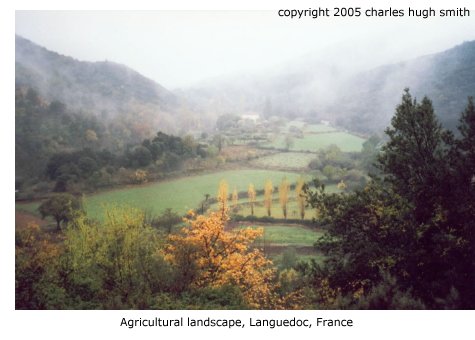
Terroir, as you can guess from its obvious similarity to the English "territory" (yes, about a third of the English language has roots in French), is a particular wine-producing area defined by its unique combination of soil and weather. In France, it's a smaller piece of an appellation or region (Champagne, Rhone, etc.). Shops which sell a variety of local products (jams, wine, creme de marron, pate, "agriculture biologique" products, etc.) use "terroir" in their signs, so it also denotes products unique to the local region. If you're being subjected to wine patter by snobs, then the root word may seem to be "terror." 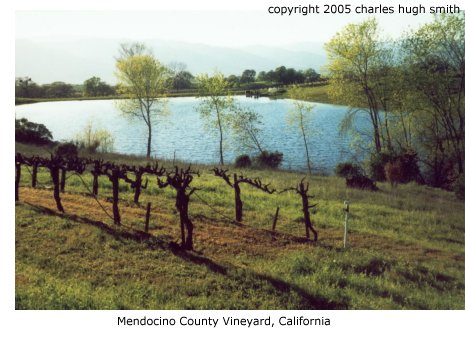
Ironically, perhaps, the people who actually manage the vineyards and make the wine--in other words, the real experts--have in my experience been uniformly down-to-earth. If they use "terroir," it's apologetically, or with an emphasis which communicates their awareness of its frou-frou connotations. But it does have a meaning to them, for it defines and shapes their work. Anyone who's seen the film "Sideways" knows all about pinot noir grapes--remember the rant against merlot?--but if you really want to understand terroir and pinot, make a pilgrimage to the Anderson Valley (route 128) in Mendocino County, California and feel how the weather changes as you approach the Pacific. Grapes grow over vast tracts of California; on a recent drive to Los Angeles, we stopped in Buttonwillow, a fast-food haven in the flat Central Valley just north of the Tehachapi Mountains. To stretch my legs I walked past the truck stop and down a road surrounded by vineyards. In the hazy plains of the great Central Valley, where the weather hardly changes for hundreds of miles, no one talks of terroir. And no doubt the grapes are just as useful as those fawned over in locales far to the north. But terroir has its limits. In Napa Valley, there are many microclimates and soil types; each one defines a terroir-- for example, the Rutherford Dust Society. But what surprises the casual visitor is how many varieties of grapes can be planted within the confines of a 100-acre vineyard. Though the vineyard is within a terroir, there are variations in weather and soil even in such a small parcel. The knowledgeable vitner plants according to the slope, soil depth and type; as a result, one relatively small vineyard (90 acres planted) might have four or even five varietals (for instance, zinfandel, Rhone, petite syrah and grenache), depending on the variety of terrain and soil on the parcel. So if you really want to sound knowledgeable about wine, drop in "deficit irrigation," "fractured shale," "pressure bomb," "fertigation," "subsurface drainage," "dryland farming," or that most feared result of inadequate frost protection, "defoliation." If you can weave these into a conversation, you'll leave the wine poseurs blinking in bafflement. Long before you get to hints of blackberry and chocolate, you have to plant and nurture the vineyard and worry over the moisture content and the berries. But enough about terroir--let's just enjoy the scenery, shall we? July 8, 2005 Ernest Lehman, Screenwriter 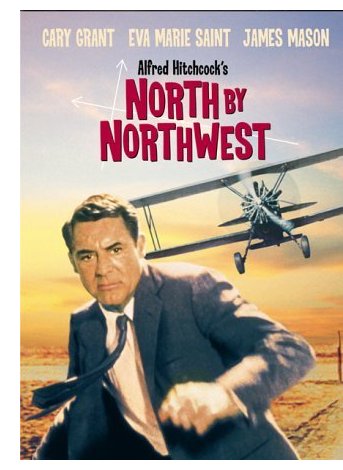 Master screenwriter Ernest Lehman just passed on at the age of 89, and in his honor I'll highlight some
favorite bits of his work. He wrote the scripts to many classic films--The Sweet Smell of Success, Sabrina,
Sound of Music, West Side Story, Who's Afraid of Virginia Woolf? and of course North by Northwest.
A great film is necessarily a collaboration, and one which must fire on all cylinders; poor casting, a lousy
soundtrack or bad editing can ruin even the best screenplay. In this Lehman was fortunate, working often with
master directors Alfred Hitchcock and Billy Wilder and one-of-a-kind actors like Cary Grant.
Master screenwriter Ernest Lehman just passed on at the age of 89, and in his honor I'll highlight some
favorite bits of his work. He wrote the scripts to many classic films--The Sweet Smell of Success, Sabrina,
Sound of Music, West Side Story, Who's Afraid of Virginia Woolf? and of course North by Northwest.
A great film is necessarily a collaboration, and one which must fire on all cylinders; poor casting, a lousy
soundtrack or bad editing can ruin even the best screenplay. In this Lehman was fortunate, working often with
master directors Alfred Hitchcock and Billy Wilder and one-of-a-kind actors like Cary Grant.
Indeed, it's difficult to imagine anyone but Cary Grant in North by Northwest's lead role as Roger Thornhill. But that doesn't subtract from the urbane wit of the dialog or the magic of Lehman's careful character- building touches. Of course no one caught in Thornhill's lethal predicament would be as cool as Grant, but that is part of the film's pleasure--seeing someone manage extreme duress with the sort of self-deprecating aplomb we would wish for ourselves. Consider this brief exchange between a baffled and increasingly annoyed Grant and an icy George Mason: GRANTThough there is broad comedy in Grant's line--he is, after all, a prisoner of thugs wielding guns--and in Mason's witty rejoiner, more than a hint of Mason's sinister disbelief shines through. In a lesser writer's hand, this would have been reduced to a heavy-handed threat or shopworn demand to be freed. Later, in one of his first scenes with Eva Marie Saint in the railcar, Grant lights her cigaret (how 60s). Lehman takes a mundane romantic cliche which we've seen a thousand times and transforms it into a telling character study. On each side of the match cover, we see three large letters: R O T.This play on the letter "o" and zero reveals his self-deprecation twice in only three lines. Try matching that, or finding such a similarly compressed exchange in lesser films. The next sequence makes wicked fun of his career in advertising, offers up a classic come-on and his witty reply in just two lines. MARIE SAINTA great film depends not on special effects but on dialog like this, where every exchange does triple-duty. Adieu, Ernest Lehman, and thanks for the great scripts you gave us over the years. July 7, 2005 Do Average Citizens Know More Than Their Leaders? Note: This entry was written before I learned of the London bombings. The latest issue of BusinessWeek features yet another article fingering the global savings glut as the cause of all the global imbalances I have discussed at length (What this Country Needs Is a...Good Recession). If it is true that average workers around the world have accumulated $11 trillion in savings, and are adding $1 trillion or so every year, then we can reach several conclusions: How do we know they're investing their savings in bank accounts and real estate? As the article states, it's estimated that 80% of all available global savings is flowing into U.S. Treasury bonds (and we need to sell a lot of them to fund our huge deficits). If ordinary citizens were buying stocks, their banks wouldn't have so much money laying around to invest in U.S. Treasuries. As for real estate, the evidence is overwhelming that a global real estate bubble is in place. Up to a third of all new home sales in the U.S. are being made to investors; the historical average is less than 10%. So why are average citizens avoiding "risky" investments like stocks and new businesses in their own countries? Perhaps for the simple reason that they're scared. Scared of what? Of financial crises which could rob them of their savings, and of a meltdown in all flavors of financial assets. Ironically, this mass desire for the "safety" of real estate has created a global bubble of epic proportions (see "Bubble? What Bubble?") which will eventually pop, devastating real estate assets around the world. Despite the assurances of their leaders that all is well with the global economy--and on the surface, people are doing well enough to save enormous sums of money--the savers of the world are voting with their feet, so to speak, against financial risk. They are acting as if they expected a financial crisis in the near future--spending little, saving like crazy, avoiding risk, and buying "hard assets" or low-risk bonds. People around the world have learned the hard way to anticipate financial crises on a regular basis--crises which leads to the devaluation of their savings or the shriveling of their economies. Perhaps it is only we in the U.S. who are so confident in the future that we blithely spend rather than save. But it is noteworthy-- and maybe even a bit chilling--that U.S. corporations are acting more like foreign savers than U.S. consumers. U.S. companies are not investing much in new R&D and new plant, or hiring new workers, as you would if you expected good times ahead; they're amassing huge piles of cash--savings by any name--to the tune of $550 billion. If there is wisdom in crowds, then we should all be afraid, for the crowds of global savers are socking away money as if they fear a terrible financial storm is brewing on the horizon. July 6, 2005 Complacency An elderly friend of ours gave us a scare the other day. A long-time but very careful diabetic, she was found lapsing into unconscious by another friend who happened to be joining her for lunch that day. Despite her many years of careful monitoring and control of her insulin levels, she'd drifted into hypoglycemia (low blood sugar), and lost consciousness. Who knows what might have happened had she not been found early in the episode. She was surprised and mortified by the complacency which led to her collapse, and I sympathized with her for my own reasons. Just the previous day, I'd been rushing somewhere and driving too fast on city streets. Rounding a bend, I came on a pedestrian crossing midblock. I was able to brake and avoid the man, but if I'd been going a little faster or paying less attention, I might have hit him. This shook me from the easy complacency we enter as "safe drivers": no accidents in 32 years on the road, only one ticket (at 19, for turning right on a red light when a poorly lit sign precluded that otherwise legal turn), so I'm a model driver, right? Not at all, if I allow complacency to loosen my attentiveness and caution. Bad things can happen very quickly. Last month I was driving down a main city street which is divided by a high-curbed center strip of lawn. I noticed a vehicle in oncoming traffic acting erratically, and as I watched, the car veered against the curb, jumped onto the grassy divide and spun toward us. I instinctively pulled to the right and then watched in horror as the car just missed us and plowed head-on into the vehicles directly behind us, causing a five-car wreck in a matter of perhaps 3 seconds. At city-street speeds, I reckon no one was seriously hurt, but no doubt it was a traumatic (and expensive) accident for those hit. We cannot control our exposure to life's vissitudes, but complacency is surely their best ally. 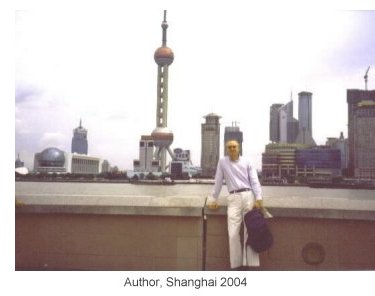 Speaking of complacency, there's an excellent piece in today's S.F. Chronicle on
China's environmental challenges. The conclusion is the same reached in my own
survey of China's environmental problems: that the enforcement
of progressive-sounding statutes is impossible in a political structure in which corrupt local authorities hold
all the levers of day-to-day decision-making.
Speaking of complacency, there's an excellent piece in today's S.F. Chronicle on
China's environmental challenges. The conclusion is the same reached in my own
survey of China's environmental problems: that the enforcement
of progressive-sounding statutes is impossible in a political structure in which corrupt local authorities hold
all the levers of day-to-day decision-making.
Given the horrendously inefficient nature of China's power grid and industrial plant, you have to wonder how much energy could be saved if the Chinese government were to invest the same billions they're spending to buy up petroleum assets on conservation/efficiency/pollution improvements to their infrastructure. Given that China expends something on the order of 4 times as much energy as the developed world per unit of GDP, the calculation is rather easy: China would pocket vastly more fossil fuels by making its infrastrucure more efficient than it ever can by investing in oil companies. But as the saying goes, that's too much like right, so China will continue to follow the West's profligate wastrel ways rather than learn from our wasteful mistakes. Date: July 5, 2005 Green Building Resources I just added a "green building" section to my resources page which lists a number of websites related to sustainable building materials and practises. Ascertaining what is actually sustainable is not easy, but any advances should be welcomed. If the topic is of interest to you, take a look at two recent articles I wrote for the San Francisco Chronicle: Green Building and LEED Green technologies Date: July 4, 2005 Self-Reliance: What It Means to Be American What is visible on July 4th is the overwhelming consumerism of a three-day weekend holiday: the glossy sales campaigns, the overdulgences of the table, and the obligatory displays of fireworks. But beneath this celebratory surface run questions about American identity and the state of grace of the American soul. 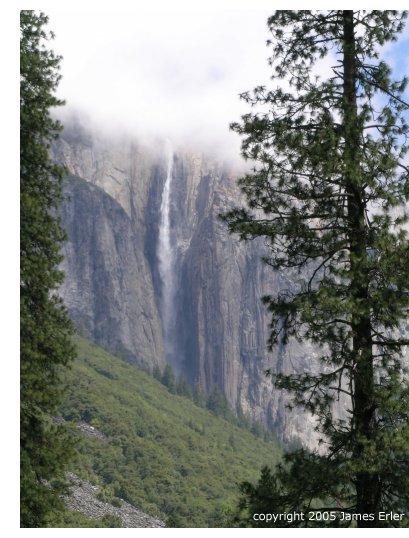 There is a darkness in that soul,
the peculiar darkness of greed, complacency and hubris. Individualism, it seems, means not the making of one's own way
but the demanding of sacrifices by others to maintain one's own lifestyle: the sacrifices of those volunteers in uniform,
the sacrifices laid on the next generations to pay our lavish medical and retirement benefits, and the sacrificing
of the very Earth itself to supply us with cheap energy, hardwood furniture and all the other gimcracks which
are stuffed in countless garages and storage facilities across the mighty suburbs of America.
There is a darkness in that soul,
the peculiar darkness of greed, complacency and hubris. Individualism, it seems, means not the making of one's own way
but the demanding of sacrifices by others to maintain one's own lifestyle: the sacrifices of those volunteers in uniform,
the sacrifices laid on the next generations to pay our lavish medical and retirement benefits, and the sacrificing
of the very Earth itself to supply us with cheap energy, hardwood furniture and all the other gimcracks which
are stuffed in countless garages and storage facilities across the mighty suburbs of America.
There is another American soul, the true one; that of Emerson, Thoreau and Muir. Emerson's essay Self-Reliance Click here for more on Emerson's view of self-reliance. At 68 years of age, Emerson passed this understanding to a 33-year old living in Yosemite Valley, John Muir. Though Emerson's visit was brief, it clearly affected Muir for the remainder of his life. His account of their meeting can be found on Peter Y. Chou's website: "Yes, the most of my years were spent on the wild side of the continent, invisible, in the forests and mountains. These men were the first to find me and hail me as a brother. First of all, and greatest of all, came Emerson. I was then living in Yosemite Valley as a convenient and grand vestibule of the Sierra from which I could make excursions into the adjacent mountains. I had not much money and was then running a mill that I had built to saw fallen timber for cottages.I keep a justly famous Emerson quote posted in my office:"Trust thyself: every heart vibrates to that iron string." Date: July 3, 2005 Will Avian Flu Trigger a Global Depression? Stories about the dangers of a flu pandemic arising from the avian flu currently scourging South Asia typically focus on references to the great flu pandemic of 1918-19 and forecasts of millions of deaths. The collapse of world trade and the world economy which would accompany such a pandemic receives less attention. The current issue of Foreign Affairs presents in frightening detail just how deadly such a virus might be (it kills 100% of all infected domestic chickens, and has killed over half of all infected humans), and just how destructive the disruption will prove to the world economy. Readers of this weblog know that various "economic cycles of history" theories (Kondratieff et. al.--see Financial Meltdown Watch in the sidebar) are forecasting a global depression within the next 5 or 6 years. While many assume the proximate cause will be financial-- inflation, the implosion of debt, etc.--the trigger might well be a global flu pandemic. As the SARS outbreak of 2003 proved, South-Asian economies are extraordinarily vulnerable to any disruption of travel and trade. SARS struck only 8,000 people, of whom 800 died, but it immediately withered travel and cost the region at least $40 billion. If the avian flu currently spreading through populations of Asian wild and domesticated birds does indeed mutate to the point it spreads via human-to-human contact, then history suggests up to one-third of all humanity could eventually be infected, and between 1% and 5% of those sickened will die. The economic impact of such a pandemic is beyond easy comprehension: as with SARS, schools would close, restaurants and theaters would be shut down, and travel to infected areas would dry up and blow away. While the pathway of viral mutation canot be predicted, the past two global flu pandemics (1958 and 1968) were avian flus which originated in South China. In 1968, it's estimated there were less than 20 million chickens in all of China; now that nation raises some 13 billion annually. Do you reckon there are more opportunities for an avian virus to jump to human now? The odds seems to favor it, and that's why experts consider it an inevitability. Frightening stuff, but important to contemplate. NOTE: An astute reader just recommended the book Devil's Flu: The World's Deadliest Influenza Epidemic and the Scientific Hunt for the Virus That Caused It Date: July 2, 2005 900 Miles per Gallon Since I do a lot of errands on my bicycle, I looked up how many calories riding a bike burns: about 500 calories an hour if you weigh about 175 pounds like I do and ride about 15 MPH (which is fairly fast, especially on a gentle upslope.) A pound of human fat contains about 3,500 calories (kilocalories, if you want to get technical, but let's just stick with the common useage). So riding at a good clip for seven hours would get you about 100 miles and burn one pound of fat. That's pretty efficient, isn't it? And sobering if you're trying to lose weight. If you bicycle an hour a day and don't eat anything extra, you can lose a pound of fat a week. (More if you add muscle mass, of course.) But bicycling 15 MPH for an hour is not that easy; you will definitely feel it by hour's end. We use the word "oil" for both petroleum and vegetable oil. As you might expect, they are both chains of hydrocarbons. As a result, a gallon of vegetable oil contains about the same calories as a gallon of gasoline (31,000 calories). This is why biodiesel fuel works as a replacement for petroleum diesel. Since a human can metabolize vegetable oil as fuel, then by simple extrapolation we can estimate that a human being could ride a bike 900 miles on a gallon of vegetable oil--or lose about nine pounds of human fat on the ride. That means that a mere 27 pounds of human fat would theoretically enable a rider to bike across the entire continental U.S. Alternatively, the rider could sip 3 gallons of vegetable oil to provide the same calories. Not a terribly enticing diet for a cross-country ride, but the take-away is simple: the human body is an extremely efficient engine, and it's difficult to burn the enormous quanitity of energy stored in 10 pounds of human fat. No wonder it's hard to lose weight, and no wonder our nation (and other developed nations) are suffering an epidemic of obesity. Here's a good calorie chart if you want to accurately calculate the burn rate for your daily exercise. The chart doesn't include cleaning house or gardening, but both qualify as moderately strenuous forms of exercise. Date: July 1, 2005 Nostalgia 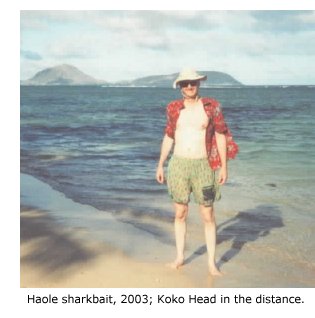 Nostalgia is a peculiar mix of emotion and memory. Scents rather famously act as powerful triggers of
recall, as do songs and other sounds. If you listen to popular music on the radio, you have
a built-in soundtrack to your life. Even though I worked on dozens of houses in my carpentry days, I can
identify each one with the songs getting airplay at the time. Boz Scaggs' Lowdown: the pole
house on the hillside above Kailua, Oahu. Fleetwood Mac's Rumors: that stucco manse up in Waialae Iki 5.
Nostalgia is a peculiar mix of emotion and memory. Scents rather famously act as powerful triggers of
recall, as do songs and other sounds. If you listen to popular music on the radio, you have
a built-in soundtrack to your life. Even though I worked on dozens of houses in my carpentry days, I can
identify each one with the songs getting airplay at the time. Boz Scaggs' Lowdown: the pole
house on the hillside above Kailua, Oahu. Fleetwood Mac's Rumors: that stucco manse up in Waialae Iki 5.
What really fires my nostalgia, however, are the surf reports which pepper Oahu radio broadcasts along with the usual traffic updates. When I hear "Makaha, 1 to 2 feet, Haleiwa, 3 to 4 feet, Sunset, 3 to 4," an undying bond with Hawaii fills every fiber of my being. It's not a love of surfing--I only recently tried the sport, despite having lived in Hawaii from 1969-1986. (Back then, the sunscreens just weren't up to protecting such a pale haole.) Though the wellspring of nostalgia is always one unique sensory memory--the scent of ginger in the first light of day, Sunday Manoa's Hawaiian Lullaby, the Myna birds' sunset cackling in the big Banyan trees across from Central Union Church on Punahou Street--the emotions released instantly transfix all of one's mind and senses. Nowadays you can get much more accurate surf reports on the Web, but a webpage will never trigger such a powerful wave of nostalgia. wessay noun, combination of 'web' and 'essay,' denoting a short essay which exploits the hyperlinks, interfaces and interactive capabilities of the World Wide Web; coined by Charles Hugh Smith on May 1, 2005, in Berkeley California. |
||
| home |